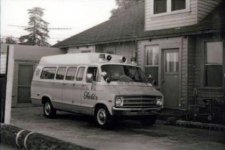I was in Arizona all last week on business. While driving from Tucson to Phoenix to catch my flight, I received a phone call from an old friend. He told me he was attending an estate sale in the city of Mountain View (CA), and found some items he thought I may be interested in. I was able to quickly establish that it was the estate of the late Bill Field. Bill was the former owner of Field's Ambulance Service which was founded in 1953, and operated until he sold it in the late 70's. His service was contracted to serve as the emergency ambulance for the cities of Sunnyvale and Mountian View, both in the heart of the "Silicon Valley".
As our phone call progressed, my friend described the ambulance related items he had discovered. They included tachographs, Dynamed jump boxes, 02 equipment, shoulder emblems, and a host of other goodies.
I had him buy most of the things he found, but I was most excited by the tachographs. One has a stainless steel housing with a cut out for a Cole-Hersee battery switch. It is an earlier model with records up to 90mph, plus time, and when the emergency equipment is activated. The other is a later model that records speeds up to 120mph as well as the electrical events.
If my memory serves me correctly, the tachograph housing appears to be built by Miller-Meteor. I plan on installing it with the 120mph tach, and mount my NOS Cole-Hersee to it as well. The other mount is a cast aluminum piece that must have been designed for an under dash installation.
As our phone call progressed, my friend described the ambulance related items he had discovered. They included tachographs, Dynamed jump boxes, 02 equipment, shoulder emblems, and a host of other goodies.
I had him buy most of the things he found, but I was most excited by the tachographs. One has a stainless steel housing with a cut out for a Cole-Hersee battery switch. It is an earlier model with records up to 90mph, plus time, and when the emergency equipment is activated. The other is a later model that records speeds up to 120mph as well as the electrical events.
If my memory serves me correctly, the tachograph housing appears to be built by Miller-Meteor. I plan on installing it with the 120mph tach, and mount my NOS Cole-Hersee to it as well. The other mount is a cast aluminum piece that must have been designed for an under dash installation.


![IMG_0363[1].jpg](/data/attachments/5/5280-ae9253a472512c0d06347546890b9b9f.jpg)
![IMG_0364[1].jpg](/data/attachments/5/5283-5ab8ce7052a9d516ec07d9828613d734.jpg)
![IMG_0365[1].jpg](/data/attachments/5/5285-16819b4a3fabb1744ff3dcb66cfd9a92.jpg)
![IMG_0366[2].jpg](/data/attachments/5/5287-f2f5f0cc356965cff83db97b7cebd1a7.jpg)
![IMG_0367[1].jpg](/data/attachments/5/5288-7fc3309c05bb6f988e5e504eb098e24d.jpg)
![IMG_0368[1].jpg](/data/attachments/5/5290-af4521ef543a856893e75f15206019ef.jpg)
![IMG_0370[1].jpg](/data/attachments/5/5291-85588f40cd10a09fcf027e597301dab2.jpg)
![Field's Amb. emblem[1].jpg](/data/attachments/5/5292-db7b11002e6002a61966ed241d23706a.jpg)

